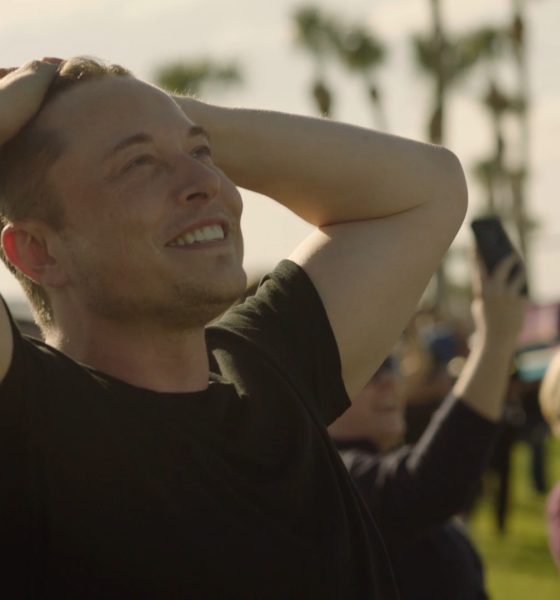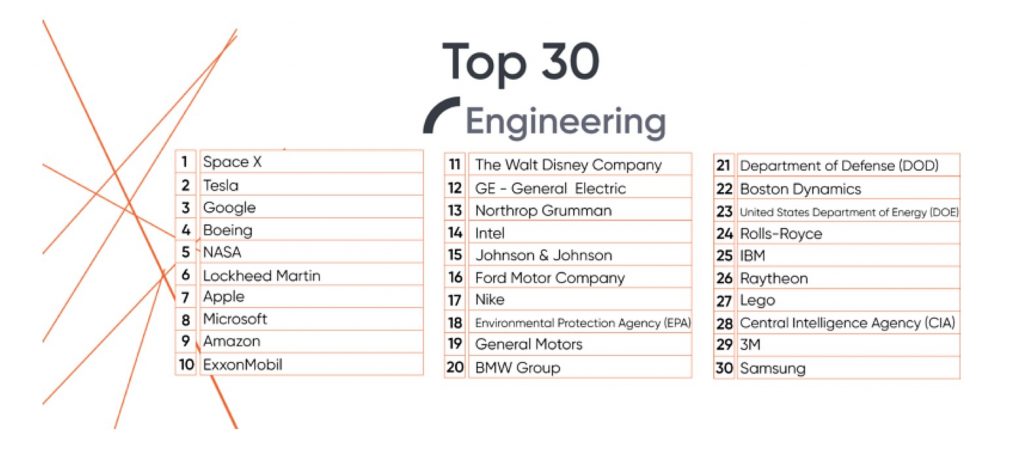

News
Elon Musk’s Tesla, SpaceX top list of most attractive employers for engineering students
Employer branding specialist Universum has released its 2019 rankings for the most attractive employers in the United States. Based on the firm’s findings, which were tabulated from a survey of tens of thousands of students from hundreds of universities, it appears that two of Elon Musk’s companies, SpaceX and Tesla, are perceived by engineering students as the best employers in the country.
SpaceX, Elon Musk’s private space company, was dubbed by engineering students as the No. 1 employer they wish to work for, dethroning NASA, which topped last year’s rankings. Among the respondents of Universum’s survey, 20.7% of engineering students listed the disruptive space firm among their Top 5 ideal companies. SpaceX moved up significantly in this year’s rankings too, as the company was ranked No. 3 in the branding firm’s survey in 2018.
Tesla stood proudly at No. 2 in Universum’s rankings, with18.7% of engineering students listing the electric car maker as one of their Top 5 ideal employers. Tesla was also ranked 2nd in the branding firm’s 2018 surveys, which all but highlights the strength of the company’s brand. This is all the more impressive if one were to consider the noise from skeptics surrounding the company, which have largely dominated the news cycle around Tesla for the past months.

Both Tesla and SpaceX are known for being workplaces that are incredibly challenging. During the early days of SpaceX, the company’s recruiting pitch was simple: it was the “special forces” in the space industry. This pitch, which all but highlights the hard work and dedication required of all SpaceX employees, all but became a beacon that attracted the most dedicated workers. As history would show, being special forces has its merits, as SpaceX currently offers employees the opportunity to work for a company that quite literally is leading the private space race.
Tesla, for its part, is known to be just as challenging as SpaceX. While one could argue that electric car manufacturing is not as complicated as rocket science, the sheer scale of Tesla’s operations is enough to keep every employee busy. As noted by a study from Handshake, a student career-services app, last year, this intense work culture is actually among the reasons why applicants consider the electric car maker as an attractive place of employment.
One common denominator between SpaceX and Tesla that is likely compelling for job-seekers is CEO Elon Musk, whose style of leadership is equal parts daunting and inspiring. While Musk is known to be a leader who demands a lot from his employees, he is also a leader that prefers to stay in the front lines. During the challenging days of Tesla’s Model X and Model 3 production ramps, Musk slept in the company’s Fremont factory, just so he could address any issues in the facility as they arose. Anecdotes from the Tesla community during the construction of GA4 also indicate that Musk was among the workers torquing bolts in the new Model 3 assembly line.
This extends to Musk’s use of Tesla’s technologies as well. As indicated in a report from The Information that featured accounts from members of Tesla’s Autopilot team, Musk uses himself as a test subject for the company’s driver-assist software. Musk’s personal vehicle is loaded with pre-released “development build” Autopilot versions, which allow him to push the driver-assist software to its limits. This practice has allowed Tesla to quickly spot Autopilot’s areas for improvement, though according to the publication’s sources, it has also resulted in Musk finding himself in “situations that many of us wouldn’t want to be in.”

Elon Musk
Elon Musk and Tesla AI Director share insights after empty driver seat Robotaxi rides
The executives’ unoccupied tests hint at the rapid progress of Tesla’s unsupervised Robotaxi efforts.

Tesla CEO Elon Musk and AI Director Ashok Elluswamy celebrated Christmas Eve by sharing personal experiences with Robotaxi vehicles that had no safety monitor or occupant in the driver’s seat. Musk described the system’s “perfect driving” around Austin, while Elluswamy posted video from the back seat, calling it “an amazing experience.”
The executives’ unoccupied tests hint at the rapid progress of Tesla’s unsupervised Robotaxi efforts.
Elon and Ashok’s firsthand Robotaxi insights
Prior to Musk and the Tesla AI Director’s posts, sightings of unmanned Teslas navigating public roads were widely shared on social media. One such vehicle was spotted in Austin, Texas, which Elon Musk acknowleged by stating that “Testing is underway with no occupants in the car.”
Based on his Christmas Eve post, Musk seemed to have tested an unmanned Tesla himself. “A Tesla with no safety monitor in the car and me sitting in the passenger seat took me all around Austin on Sunday with perfect driving,” Musk wrote in his post.
Elluswamy responded with a 2-minute video showing himself in the rear of an unmanned Tesla. The video featured the vehicle’s empty front seats, as well as its smooth handling through real-world traffic. He captioned his video with the words, “It’s an amazing experience!”
Towards Unsupervised operations
During an xAI Hackathon earlier this month, Elon Musk mentioned that Tesla owed be removing Safety Monitors from its Robotaxis in Austin in just three weeks. “Unsupervised is pretty much solved at this point. So there will be Tesla Robotaxis operating in Austin with no one in them. Not even anyone in the passenger seat in about three weeks,” he said. Musk echoed similar estimates at the 2025 Annual Shareholder Meeting and the Q3 2025 earnings call.
Considering the insights that were posted Musk and Elluswamy, it does appear that Tesla is working hard towards operating its Robotaxis with no safety monitors. This is quite impressive considering that the service was launched just earlier this year.
Elon Musk
Starlink passes 9 million active customers just weeks after hitting 8 million
The milestone highlights the accelerating growth of Starlink, which has now been adding over 20,000 new users per day.

SpaceX’s Starlink satellite internet service has continued its rapid global expansion, surpassing 9 million active customers just weeks after crossing the 8 million mark.
The milestone highlights the accelerating growth of Starlink, which has now been adding over 20,000 new users per day.
9 million customers
In a post on X, SpaceX stated that Starlink now serves over 9 million active users across 155 countries, territories, and markets. The company reached 8 million customers in early November, meaning it added roughly 1 million subscribers in under seven weeks, or about 21,275 new users on average per day.
“Starlink is connecting more than 9M active customers with high-speed internet across 155 countries, territories, and many other markets,” Starlink wrote in a post on its official X account. SpaceX President Gwynne Shotwell also celebrated the milestone on X. “A huge thank you to all of our customers and congrats to the Starlink team for such an incredible product,” she wrote.
That growth rate reflects both rising demand for broadband in underserved regions and Starlink’s expanding satellite constellation, which now includes more than 9,000 low-Earth-orbit satellites designed to deliver high-speed, low-latency internet worldwide.
Starlink’s momentum
Starlink’s momentum has been building up. SpaceX reported 4.6 million Starlink customers in December 2024, followed by 7 million by August 2025, and 8 million customers in November. Independent data also suggests Starlink usage is rising sharply, with Cloudflare reporting that global web traffic from Starlink users more than doubled in 2025, as noted in an Insider report.
Starlink’s momentum is increasingly tied to SpaceX’s broader financial outlook. Elon Musk has said the satellite network is “by far” the company’s largest revenue driver, and reports suggest SpaceX may be positioning itself for an initial public offering as soon as next year, with valuations estimated as high as $1.5 trillion. Musk has also suggested in the past that Starlink could have its own IPO in the future.
News
NVIDIA Director of Robotics: Tesla FSD v14 is the first AI to pass the “Physical Turing Test”
After testing FSD v14, Fan stated that his experience with FSD felt magical at first, but it soon started to feel like a routine.

NVIDIA Director of Robotics Jim Fan has praised Tesla’s Full Self-Driving (Supervised) v14 as the first AI to pass what he described as a “Physical Turing Test.”
After testing FSD v14, Fan stated that his experience with FSD felt magical at first, but it soon started to feel like a routine. And just like smartphones today, removing it now would “actively hurt.”
Jim Fan’s hands-on FSD v14 impressions
Fan, a leading researcher in embodied AI who is currently solving Physical AI at NVIDIA and spearheading the company’s Project GR00T initiative, noted that he actually was late to the Tesla game. He was, however, one of the first to try out FSD v14.
“I was very late to own a Tesla but among the earliest to try out FSD v14. It’s perhaps the first time I experience an AI that passes the Physical Turing Test: after a long day at work, you press a button, lay back, and couldn’t tell if a neural net or a human drove you home,” Fan wrote in a post on X.
Fan added: “Despite knowing exactly how robot learning works, I still find it magical watching the steering wheel turn by itself. First it feels surreal, next it becomes routine. Then, like the smartphone, taking it away actively hurts. This is how humanity gets rewired and glued to god-like technologies.”
The Physical Turing Test
The original Turing Test was conceived by Alan Turing in 1950, and it was aimed at determining if a machine could exhibit behavior that is equivalent to or indistinguishable from a human. By focusing on text-based conversations, the original Turing Test set a high bar for natural language processing and machine learning.
This test has been passed by today’s large language models. However, the capability to converse in a humanlike manner is a completely different challenge from performing real-world problem-solving or physical interactions. Thus, Fan introduced the Physical Turing Test, which challenges AI systems to demonstrate intelligence through physical actions.
Based on Fan’s comments, Tesla has demonstrated these intelligent physical actions with FSD v14. Elon Musk agreed with the NVIDIA executive, stating in a post on X that with FSD v14, “you can sense the sentience maturing.” Musk also praised Tesla AI, calling it the best “real-world AI” today.








